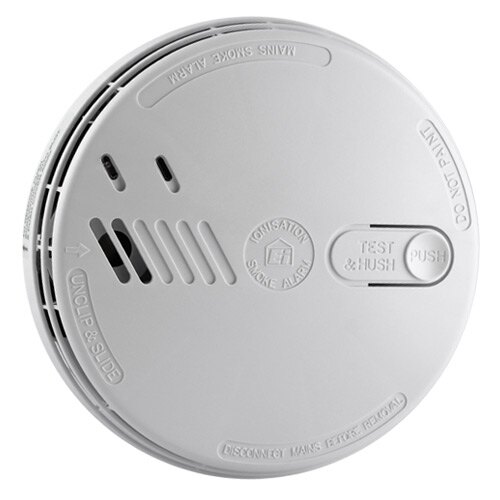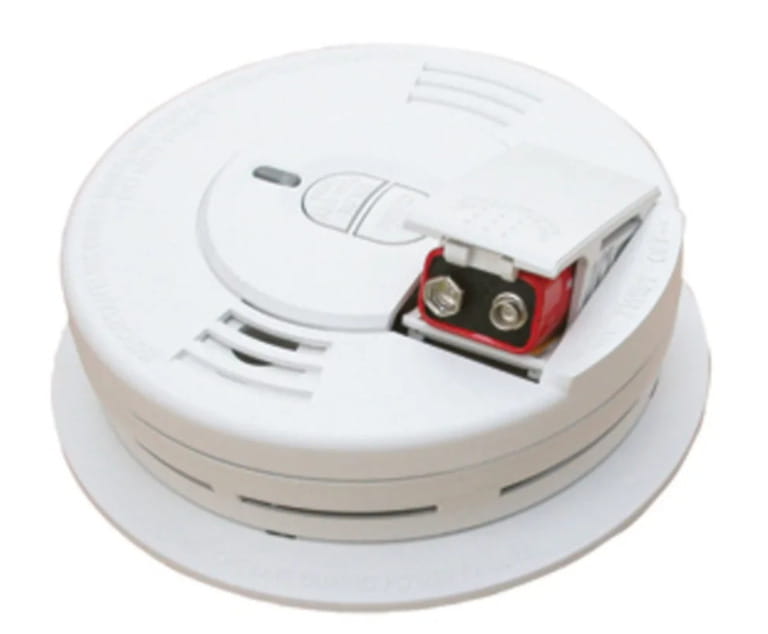A smoke alarm is one of the common devices installed in many places of the house, with the function of giving a warning signal when there is a smoldering fire, large fire or smoke.
However, false alarms often appear when you cook or smoke, which causes the false signals to sound and they affect the living space in your home. That's why it's important to invest in a quick smoke or carbon monoxide alarm over the phone. In addition, the market offers a variety of smoke alarms with modern design, adding many other features such as easy mute and warning before activating the siren, self-checking and street lights, motion activated...
Moreover, some modern apartments or multi-storey houses always need to ensure safety, from the assembly of the electric stove to the connection system, there are warning devices. Equipped with smart smoke alarms is essential to ensure safety.
As behomemate mentioned above, this device has been upgraded, the most common of which are sensors using ionization or photoelectric sensors, similar to traditional and smart smoke detectors. In addition, the smoke detector integrates a self-test feature, which helps to monitor the battery and sensor functions directly related to the phone when troubleshooting.
Thereby, they will sound the smoke alarm when the smoke alarm with the home automation system. On the other hand, they can also be viewed as Wi-Fi smoke detectors. Once the alarm is triggered, the smoke detectors now use Wi-Fi or similar communication technology to connect to the smart home hub and smartphone app.
If the fire alarm is false, the phone app can also be used to turn off the alarm. Overall, installing a smart smoke alarm at home will help you feel safe even when you're out and about, but still know what's going on. To better understand the smoke alarm types, let's analyze below.
1. Ionisation smoke alarm

Ionisation alarms are the cheapest graded alarms available today. They work primarily by using a small radioactive source to induce electric currents in alarm bells. In case if smoke comes in, this will change the current, but when too much smoke is detected, the alarm will sound. In addition, they have continuous electrodes and conduct low-level currents through ionized air.
When smoke particles enter the air, ionized air disrupts this current, triggering an alarm. Primarily detects small, less visible and earlier fire particles with photoelectric alarms. However, they are not suitable for use in or near kitchens prone to false alarms due to cooking. Suitable for bedroom or ground floor.
2. Photoelectric smoke alarm

Photoelectric smoke alarms are used by light sensors and light beams to detect smoke. In general, the light beam is directed away from the sensor, but when there is a large fire, the smoke particles will disperse the beam, then redirect the light to the sensor, triggering an alarm. Primarily intended for the detection of large fire particles, this will be seen earlier with ionization sensors. Better at dealing with smoldering fires.
3. Optical smoke alarm

A smoke alarm that uses an infrared beam to detect smoke. On the market they cost more than ionization alarms but can be used in most homes. Suitable for detecting large smoke particles originating from smoldering, slow fires such as those caused by overheated electrical wires. Often used for bedrooms, living rooms, dining rooms, aisles and corridors. In particular, do not use it in the kitchen but you can install it nearby.
4. Heat smoke alarm

Unlike other smoke alarms on the market, this smoke alarm uses heat meaning that instead of detecting smoke, they will give an alarm signal using a thermistor to measure the air temperature. If they reach the limit of about 58°C an alarm will sound.
They are therefore ideal for kitchen assembly as they do not generate false alarms when cooking causes smoke or steam. In addition, these smoke alarms are also for use in garages, as they are not triggered by exhaust fumes or dust from machinery. On the other hand, they should not be installed in other rooms as they do not provide the quick response the smoke alarm will give.
5. Multi sensor smoke alarm

This is considered a two-in-one combination of not only optical sensor smoke alarm but also thermal sensor, which is convenient for detecting both smoke and heat. From there they can react quickly to all types of fire such as slow, smoldering or fast burning flames. You also don't have to worry about both sensors giving false alarms as they are continuously intelligently monitored. Ideal for bedrooms, living rooms, dining rooms, terraces and hallways.
6. Battery smoke alarm

Most smoke alarms are battery-powered and require a backup battery except in an emergency or once a year to change the battery. In addition, to ensure smooth and correct alarms, it is recommended that you test the alarm at least every six months by pressing the test button for it to function properly.
If the signal battery is running low, the alarm will alert the listener with an intermittent chime. That's when you need to change the battery as quickly as possible. On the other hand, you can also invest in smoke alarms that incorporate a 10-year battery life, which will save time and reduce annual battery replacement costs. However, you need to replace the entire device once the battery runs out.
7. Main smoke alarm

The main alarm will be connected to the common or separate power sources in the house, so you do not need to keep changing batteries constantly to keep them working. In addition, they are equipped with a built-in battery to ensure that the smoke alarm remains active in the event of a power cut or power system failure.
Notably, buildings in the UK are required to have a grid alarm system installed, as the installation needs to be connected to the mains electricity, and they are installed by a qualified electrician to ensure power. Go accurately and safely.
8. Interconnected smoke alarm

When smoke alarms are connected, a level of safety coverage is provided by when one of the smoke alarms is activated, the other alarms also sound. No matter where you are in the house, you can hear the alarm sound from smoke alarms. On the other hand, smoke alarms can connect wirelessly using radio frequency, which avoids complicated or disruptive cable installations.
9. Dual sensor smoke alarm

This is also a special type that combines a photoelectric sensor and an ionization sensor, called a dual sensor. They are rated as the safest smoke and fire detectors available today. They are capable of detecting not only burning and smoldering fires, but also smaller such.
10. Combined Smoke and Carbon Monoxide smoke alarm

This type of alarm combines two forms of smoke detection and CO alarm in the same ceiling mounted device. This helps you reduce your budget and limit the amount of space in your home.
While they look similar on the outside, they are mainly powered by batteries or mains or a combination of both, but batteries are sometimes a backup power source for the mains when there is a problem. Besides, there are several linked together to be able to detect a variety of smoke, which in turn can alarm all rooms. And this linkage is often low cost with radio-linked smoke alarms.
On the other hand, current smoke alarm devices are equipped with mute buttons, in case of false alarms such as when cooking. Some other functions like sleep easy allow you to turn off the alarm if the battery beeps low in the middle of the night. In addition, every smoke alarm needs to be replaced every 12 months.
And batteries also include a variety of batteries such as alkaline batteries that need to be changed every year or rechargeable lithium batteries, which will extend the life of the device. Forms of operation take place only need to be installed by a qualified electrician.
Conclusion
A smoke alarm device is essential for daily life activities, with modern technology these days has combined many features to facilitate the life of consumers. Investing and installing right in the center of the house not only ensures you and your family are always safe wherever you are in the house, but also provides a variety of signals to you through the application on your phone or If your family has children, it is very useful to equip a smoke alarm because it provides an instant signal when detecting the smallest fire in your child's room when they accidentally touch its sources of smoke, this helps quickly when you are not at home. In short, a smoke alarm is essential for your home's space.











